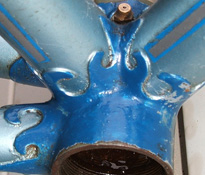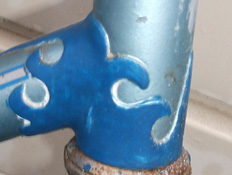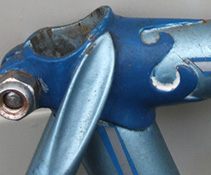Vol. 2, Issue 43 – January / February 2013
Posted: Monday 14th January 2013
A Happy New Year to all our readers from Peter and Patricia. We have booked our first cycling holiday for Gabbice Mare in Italy so we have something ‘in the book’ to look forward to. We also hope for a later trip either to Garmisch Partenkirken in Bavaria or to Wasserburg on Bodensee, the latter not quite as easy for us since the door-to-door flights from Stansted to Friedrichshafen have been dropped. However we can do it by a flight to Munich and the train south from there. The boss of Ryanair seems to have it in for us as the flights to Rimini, close to Gabbice, have also been dropped this year. Luckily Ancona is not too far away and the hotel owners have been very accommodating with transfers.
Well, that is the travelogue over and now on to Geoff Waters brain teaser:
THE CLASSIC CYCLIST’S NEW YEAR QUIZ, 2013
Compiler: Geoff Waters
Following the 30th Olympiad, London 2012, this quiz has a strong Olympic flavour
Attempt all questions. Answers and score ranking at the end
One mark for each correct answer unless otherwise stated
1. The Olympic Games have been held in London on three separate occasions When was the first time they were held there?
a) 1900 b) 1904 c) 1908
2. Which one of the following British cyclists won a cycling silver medal in the road race at the 1912 Stockholm Olympics which was won by the South African Rudolph ‘Okey’ Lewis?
a) Bill Bailey b) Leon Meredith c) Freddie Grubb d) Tiny Johnson e) Harry Ryan
3. Which one of the following post-WWII British lightweight builders produced a track/path model dubbed ‘Olympic Sprint’?
a) Hobbs of Barbican b) Jack Sibbit c) Johnny Berry d) Claud Butler e) Ephgrave f) Paris
4. Who was the first Australian cyclist ever to win an Olympic cycling gold medal?
a) Hubert Opperman b) Lionel Cox c) Dunc Gray d) Russell Mockridge e) Phil Anderson
5. Who was the British cyclist who took the bronze medal in the road race at the 1956 Melbourne Olympics?
a) Alan Jackson b) Dave Bedwell c) Bill Bradley d) Stan Brittain e) Ray Booty
6. When was the Olympic road race first held as a mass–start event rather than as a long distance individual time trial?
a) Los Angeles 1932 b) Berlin 1936 c) London 1948 d) Helsinki 1952 e) Melbourne 1956
7. When was the first Olympic cycling event for women – a road race won by Connie Carpenter of the US – held?
a) Rome 1960 b) Mexico 1968 c) Montreal 1976 d) Moscow 1980 e) Los Angeles 1984
8. Which one of the following Hour Record holders also won an Olympic cycling gold medal?
a) Roger Riviere b) Eddy Merckx c) Francesco Moser d) Ercole Baldini e) Jacques Anquetil.
9. Who was the pre–WWII Italian Tour de France winner who was found dead under mysterious circumstances, allegedly assassinated by Italian fascists, while on a solo training ride in June 1927?
a) Ottavio Bottecchia b) Learco Guerra c) Alfredo Binda d) Constante Girardengo
10. Which classic British lightweight’s name is hidden in the following anagram?
[3 marks]
BIB FOR BACON BASH
11. To obtain a medium gear of 72 inches with the inch pitch block chain transmission system requires a cog x chainwheel combination of:
a) 7 x 24 b) 8 x 24 c) 9 x 24
12. Shimano, noted for bicycle gear systems, is also a leading manufacturer of which one of the following items of sports equipment?
a) golf clubs b) fishing reels c) fencing foils d) tennis rackets e) cricket bats
13. Italian classic roadman Fiorenzo Magni, who passed away in October 2012 aged 91, is credited with having introduced the first ‘extra sportive’ team sponsor into Continental pro road racing in the 1950s. Who was his team’s extra sportive sponsor?
a) St. Raphael b) Ignis c) Molteni d) Nivea e) Carpano f) Tricofilino
14. Which one of the following cycling journalists was not a contributor to Sporting Cyclist magazine?
a) Jean Bobet b) Charlie Ruys c) Roger St. Pierre d) H.H. England e) J.B. Wadley
15. Which one of the following was not a classic French–built lightweight?
a) Stella b) Alcyon c) Helyett d) Gitane e) Cilo f) Mercier
16. Who was the cranky inventor who featured in the humorous classic Williams chainwheel advertisements in the cycling press?
a) Heath Robinson b) Honk c) D. Rebour d) Professor Eddywilly
17. Match the following 20th century Continental roadmen to their nicknames:
a) Roger de Vlaeminck b) Jean Robic c) Marino Basso d) Bernard Gauthier e) Frans Verbeeck [5 marks]
‘Mr. 1000 volts’
‘The flying milkman’
‘The Gypsy’
‘The hobgoblin of the Brittany moor’
‘Monsieur Bordeaux–Paris’
18. Which one of the following was not a classic Italian lightweight?
a) Automoto b) Legnano c) Atala d) Frejus e) Fiorelli f) Pogliaghi g)Masi
19. After being opposed to the use of derailleur gears in the Tour de France for years, race director Henri Desgrange finally relented. In which year were derailleur gears first allowed in the Tour de France?
a) 1930 b) 1935 c) 1937 d) 1939
20. Which company introduced the quick release ‘bivalent hub’, allowing the rear wheel to be removed without disturbing the freewheel and chain and rendering the front and rear wheels interchangeable?
a) Maillard b) Campagnolo c) Zeus d) Cinelli e) Gipiemme f) Shimano
21. What machine did the Swiss Ferdi Kubler ride to victory in the 1950 Tour de France?
a) Frejus b) Fiorelli c) Atala d) Bianchi e) Bottecchia f) Cilo g) Willier h) Pogliaghi i) Legnano
22.. Which one of the following was not a rear gear mechanism produced by Campagnolo?
a) Paris–Roubaix b) Tour de France c) Gran Sport d) Valentino e) Croce d’Aune f) Record
23. Which one of the following component manufacturers briefly marketed a ‘clipless pedal’ system during the 1970s long before Look, Time etc.?
a) Campag b) Mavic c) Gipiemme d) Suntour e) Cinelli e) Zeus f) Martano
Answers at end of newsletter
In L N 42 I explained my theory on the comfort of the new style bars and brake levers. As cited I first fitted a pair of the new shape Compact bars to my Van Nicholas. As I expected the set-up was more comfortable and worth doing for the small amount of money involved. However, I knew I could be even more comfortable with the Shimano Ultegra 6700 levers as fitted on the Colnago. These, combined with the bars, give such a comfortable resting place for the hands and considering the amount of miles I will clock up over the next few years it is well worth doing.
Brain starts to click here, shall I buy a complete new Ultegra drive set-up for the Van Nic or shall I buy Dura Ace for the Colnago and switch over the whole drive, which is very low mileage, from Colnago to Van Nic? To put you out of your misery the Colnago now has Dura Ace – the bad news is that it has poured with rain nearly every day since and I don’t want to get my ‘sunny-day’ bike wet, do I. I have been out quite a bit during this spell but the roads are still wet and dirty even on the dry days. Curse those farmers and their sugar beet crop. However, I have clocked up a lot of miles with the new set-up on the winter bike (Van Nic) which is of course complete with mudguards. So far this winter rain has been more of a feature than cold weather so the mudguards are getting more work than the hand-warmers which still sit snugly in their little plastic bags.
Also as related in the last edition I took my 1957 Cinelli Corsa to L’Eroica and, to make it feasible to tackle the hills and terrain, I made some changes to it. The major one was to take off the 47/50T Durax chainset and substitute a Stronglight/TA set to give much lower gears. What I didn’t do was to take off the NOS Universal brake blocks which I have now done, shutting stable door after horse has bolted comes to mind. I have never really got on with Campag bar-end levers and just before we left I changed these for a pair of Simplex retrofiction down tube levers for the event.
When these levers were introduced to the UK a lot of road racers switched to them as the Campag levers had to be set up so tight they could hardly be moved in order to stop them slipping at that crucial moment in a race, and even then it was known to happen.
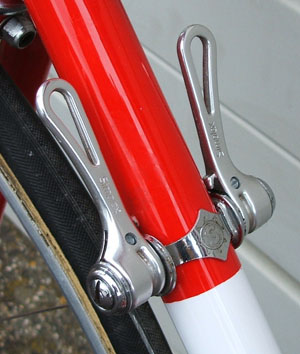
The Retrofrictions really are the sweetest and smoothest non-indexed down tube gear levers there are. There is an exploded diagram of these levers at the bottom of the page and you can see the spring which counters the ‘pull’ of the gear mechanism.
Having said that, I have a pair (or is it two pairs?) of Suntour Power levers and they look very promising. I don’t know how they work since they have never been fitted onto a bike yet as they are rather new for most of the machines we ride as classics.
The next step for the Cinelli will be to replace the Simplex with period Campag levers but my plan is to have them drilled or hollowed out to save a gram or two to make up for the higher gears – if only! I’ve really got into this Drillium thing; wish I was more of a dab-hand with drills – I don’t think I have ever drilled a hole exactly where I want it. Maybe this is because I have never had a drill stand.
Another job yet to be done is to change Patricia’s 32T TA (Touring) inner chainring for a 34 which I don’t have as yet – we are still looking for one, hint-hint. The gears were set up in a way which meant that the chain was slack in certain combinations and she wants a 34 ring to obviate this. It is the 6-arm ring which bolts inside the outer TA 5-pin touring ring.
My next project will be to restore a 24″ R O Harrison road frame that I recently acquired – it was one of those machines without a single period correct component on it so a lot of pieces go straight in the bin – they are that bad. I am chasing down the model name and have narrowed it down to either The Lyta (current favourite – top of the range model), The Super Circuit or Continental Superbe. It has fancy lugs, as can be seen below, with horrible rattle-can paint job to be removed ASAP.
Having scraped away the paint to find the frame I found, or thought I did, the indistinct number which is 1?5206 with the critical number illegible through bad stamping on the curves of the BB as it includes the point where the chainstays enter the shell and so curves in two directions. There is a separate number 350 which is much larger. Some contract painters used to stamp their own number on the B B shell so as to identify it in their paint shop,
However, when I took the forks from the frame it was clear that the actual frame number was:
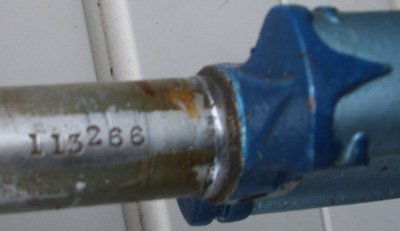
113266, which just shows how easy it would be to get the numbering completely wrong without recourse to the better-stamped column. For a few days I was convinced this was a 1955 frame due to the supposed ‘5’ which was the third number on the BB, or so I thought. As R O Harrison died in 1954 the numbering would have meant that he didn’t build this one.
The forks also had the re-enamellers ‘350’ stamp further up the column. This numbering would have been essential as they could have frames from several builders in the shop at the same time – imagine the rumpus if they returned a frame to R O Harrison, say, which had been built at Ephgrave and vice versa. The sprayers wouldn’t have time to familiarise themselves with numbering systems from dozens of builders so in this case they probably had a job sheet with ‘350’ – R O Harrison Old English transfers on down tube plus R O H transfers on head and seat tube. Reynolds 531DB on seat tube.
The previous owner had the R O Harrison for 54 years, having bought it from a serious racing man when he was 18. At this time it was fitted with all top-grade equipment. The front and rear ends are Stallard without a gear hanger, not the ones with the long spearpoint so not built with Osgear in mind.
Now for sleepless nights while I decide what colour to have the frame and forks sprayed. When cleaning paint off the front and rear ends I found that they were chromed, so I hope to be able to leave them this way as they should look OK with track nuts on. Normally I find that one can discover traces of original paint on the fork column, or somewhere inside tubing or drillings – but not a trace on this one. I would like black with white seat tube panel and head tube but the decals have a black outline so this would leave a spidery looking effect. I have too many green bikes, especially British Racing Green, to you car enthusiasts out there, so that is one colour out. I have at least two in blue livery and two red as well. I have thought of Salmon colour with black head and seat tube panel, that would be different but I guess I ought to talk it over with Mario the painter before I decide. I know he loves doing ‘metallic/flamboyant finishes and Patricia’s red Hobbs is a great example of this.
While I puzzle this one out I still have my carbon Colnago to play with and I cannot wait until it is dry enough to take out my Mercian track with the wood sprints.
I have always coveted the Shimano C50 carbon wheels which, as the name says, have 50mm deep rims. To my delight and surprise, the birthday fairy arrived last November with a pair tucked under her wings. I realised that most of my inner tubes were 42mm long with a couple of 50s. As an aside I am finding it difficult to locate tubes with the older 25mm valves which look right on classic ‘flat’ rims. Nowadays 42 is sometimes referred to in listings as short. Back to the new wheels, I did enquire and was told I would need a 40mm valve extension to go on the 42 valves. I ordered a pair from Planet X and they duly arrived by post the next morning.
Not knowing how to assemble them I Googled ‘Valve Extensions’ and was mortified to come across page after page of horror stories about valve extensions of various makes. Some slowly deflated, others wouldn’t take any air at all, sometimes after previously being used successfully and it seemed as if valve extensions were the work of the devil. A current theme is that the metal to metal threading will never be airtight at the high pressures we use and the answer is PFTE tape wrapped around the threads. The valves being about 5mm diameter you can just imagine the size of the threads and the thought of trying to wrap four layers of tape before re-assembling makes the blood run cold.
This lack of airtight threading is the cause of most complaints about slow leakage. There are several different types and makes of extensions and one common problem is that in some cases the existing valve is hidden inside the extension at the join. It seems that as one rides along this caused the tiny locking ‘nut’ to work its way down to where it would be if you had tightened it after inflation. Obviously it would not be as tight but still enough to stop air going in. Hence the complaints of tyres refusing to inflate after previously being fine.
Having read these horror stories I took the easy way out and ordered three tubes with 80mm valves (one for a spare).
The wheels duly arrived complete with rim tapes and valve extensions so now I have the three long one-piece valves plus two pairs of extensions. One of these came from Planet X, renowned for their competitive pricing. I puzzled for a while as to the correct way to assemble them and realised that first one had to unscrew the valve core in the tube (not all tubes do this). Having done this the extension tube is screwed on and then the valve core screwed in to end. This seemed a good way to approach the problem. On top of this the extensions had tiny rubber O-rings which made me wonder if these would obviate the dreaded taping. I decided to do a test on a spare wheel, assembled the extension, put the tube inside the tyre on the rim of the wheel and then inflated to 100psi (7 bar). As I write this the pressure is still holding up after three weeks or so. It seems as if Planet X got the design right with this relatively simple approach to the problem.
I did think about moving the Fulcrum wheels from the Colnago to the Van Nicholas but realised that as I am using the V N as a winter bike would expose the wheels to all sorts of corrosion-inducing chemicals over the bad-weather months. I have said before that the councils used to spread salt crystals on the roads, it was quite easy to avoid them once cars had driven over them and spread them around. Nowadays the councils spread the salt suspended in a liquid/molasses mixture and there is no escaping the corrosive effects of this liquid on rims, cranks, pedals, etc as it splashes up.
I was tickled to read this in the TA (Tricycle Association) East News:
“Finally the story of a little misfortune:
“After riding the EACC 10 and marshalling the CC Breckland 25 the following morning (yesterday) I was trundling the tandem trike back to Norwich solo (Mark Ready having returned home the previous day). After a lunch in the wonderful Rosie Lee’s tearoom in Loddon, I saw it was raining. So put on waterproofs, with a strap round my right ankle to keep the trousers away from the oily chain.
It was only somewhat later, glancing down at an oily fluorescent trouser-bottom, that I remembered that the tandem trike has crossover-drive and the chain at the front is on the left.”
Fergus Muir
Using Tubs or Sew ups (for those across the ocean) by Steve Griffith
Many experienced riders seem to view the use of tubs as an act of eccentricity regarding them as completely impracticable: cue stories of races lost due to puncturing and evening spent on hotel rooms mending tubs whilst on tour. I used to share these views seeing tubs as essentially only suitable for the track and very short distances. That was until I went to stay with an American friend whose entire stable of machines ran on tubs I was amazed at how durable they were even surviving many miles on dirt roads. He used only the basic training tub ,the Vittoria Rally and Conti Giro and seemed to get about 800 to 1000 mile out of them.
Advantages of tubs ; the ride quality something the conventional wire on will never achieve, rims are cheap and plentiful at cycle jumbles often not given a second glance by punters who will often pay more for a hub than the same hub in sprint rim. My favourite are the Mavic SSC, simply the strongest rim ever although they cost over £100 new they can often be found in that unloved pile of sprint rims at a jumble If you puncture at high speed the tub will not roll off unlike a wire on, I believe that is the reason why they are still used in the Tour when a tyre coming off on a long Alpine descent could be fatal! Sprint rims are extremely durable: you very rarely find one worn out.
Disadvantages of tubs: gluing them on is always a messy business. You have to carry a bulky spare or two and they need to be kept at very high pressure
I use the double-sided tape if I need to replace whilst on the road. I have found the modern Kevlar protected tubs very puncture resistant, i.e. Continental , Vittoria and Schwalbe, and I recommend you buy the basic model which can be had for around £15. For general road riding they can’t be beat and you can ride a pretty long way on a punctured tub not the most comfortable but it gets you home. Avoid the temptation to use up old tubs, that is one sure way to get stuck somewhere. I still rue the day I decided to use the 60’s fat Wolber Reinforce tubs which had been decaying in a shed since then
Answers to quiz
1. c) 1908
2. c) Freddie Grubb (Leon Meredith finished fourth)
3. d) Claud Butler
4. c) Duncan ‘Dunc’ Gray won the 1 000m individual TT at Los Angeles 1932
5. a) Alan Jackson. The gold was won by Ercole Baldini (Italy) in 5:21:17. Arnaud Geyre (France) was second in 5:23:16; Jackson was third in the same time.
6. b) Berlin 1936 (The winner was Robert Charpentier of France)
7. e) Los Angeles 1984
8. d) Ercole Baldini (won the Melbourne 1956 road race and set the Hour Record of 46.394km also in 1956)
9. a) Ottavio Bottecchia (first Italian winner of the Tour de France in 1924 and 1925)
10. Anagram answer: Hobbs of Barbican
11. c) 9 x 24 (equivalent on the half–inch pitch chain system is 18 x 48)
12. b) Fishing reels
13. d) Nivea (Given the balding Magni’s rugged features, this sponsorship occasioned much hilarity at the time)
14. d) H.H. England (editor of UK Cycling magazine, 1929–1959, opposed to BLRC and mass–start road racing)
15. e) Cilo (Swiss machine)
16. d) Professor Eddywilly
17. Nicknames:
– ‘Mr 1000 volts’: c) Marino Basso (Italian, world pro road champion 1972)
– ‘The flying milkman’: e) Frans Verbeeck (Belgian, ‘eternal second’ to Merckx in the classics, 1960s & 1970s)
– ‘The Gypsy’:a) Roger de Vlaeminck (Belgian, of Romany stock; Paris–Roubaix multi–winner in 1970s)
– ‘The hobgoblin of the Brittany moor’: b) Jean Robic (French, 1947 Tour de France winner)
– ‘Monsieur Bordeaux–Paris’: d) Bernard Gauthier (French: winner of B–P 1951,1954–1957)
18. a) Automoto (French pre–WWII machine)
19. c) 1937. The Tour was won in that year by Roger Lapebie (France) who used a derailleur gear throughout the race.
20. d) Cinelli. Quick release road hubs. Discontinued subsequently.
21. a) Frejus (Iconic Italian machine of the post–WWII period. Exported worldwide)
22. b) Tour de France (model made by Simplex)
23. c) Cinelli. Pedals made in association with Adidas shoes. The sole of each shoe incorporated special grooves which slid into the pedal and were locked by a lever which had to be manually released by hand in a death–defying manoeuvre.
SCORING
2013 Classic cycling quiz (50 marks)
40–50: Congratulations! You are an aficionado
30–39: Well done, but …
20–29: Puncture prone
10–19: Ahem!
<10: You are in the broom wagon!
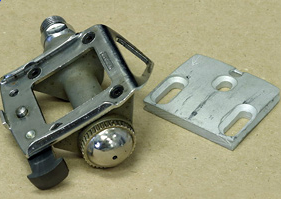
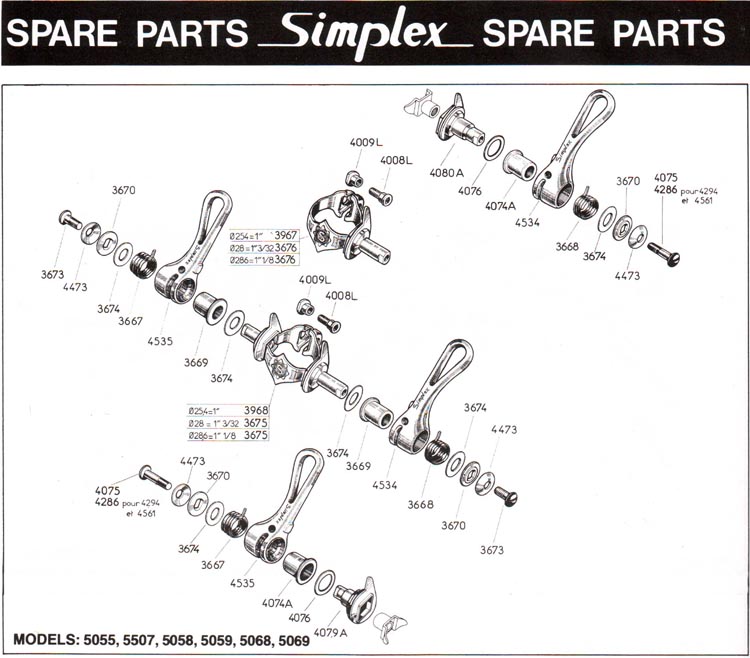
Posted: Monday 14th January 2013
This article appears in the following categories.
Upcoming Events
Whether you are looking for a gentle social meet up, or a 100-mile ride browse the community’s upcoming events and plan your next weekend outing.

